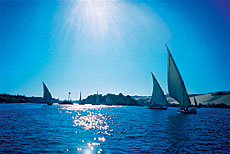Although I am no fan of early mornings, getting up at dawn on my first day in Cairo gave me a rare chance to observe this grand and most exciting of cities wake up. As I looked through the car window, I saw street vendors arranging their wares, cab drivers positioning themselves at strategic spots and women on a quest for the best bargain in the market.
Despite the early hour, there was plenty of traffic with a huge number of trucks, pick-ups, buses, vans, and cars sharing a few lanes with tractors, motorcycles and even donkey carts. I had been warned not to attempt driving, so I had arranged a driver to take me around this fascinating but overcrowded city. Khalil, my driver, could well have been a tour guide as he showed me places of interest and bombarded me with information, all delivered in perfect English.
As I only had a weekend in Cairo, I headed straight for one of its hallmarks — Giza. We arrived at the famous site and although I’d been prepared for the sight by numerous books and movies, I was still filled with awe.
Khalil told me the Great Pyramid of Khufu took 20 years to build and as I stood in front of it, I remembered this imposing 449-foot-high structure was the tallest building on earth until early in this century. South of Khufu’s pyramid is another one which honors his son Khafre. The view from Khafre’s pyramid was breathtaking with the Nile and Cairo to the east and the Menkaure Pyramid and the vastness of the desert to the south and of course, the mysterious Sphinx in front.
After a good wander around Giza and a hasty lunch, we headed south towards the ancient site of Saqqara, one of the oldest sites in Cairo which used to be the most important necropolis of Memphis, the capital city of the Old Kingdom on the opposite shore of the Nile.
Khalil told me at least three days were needed to explore all 16 pyramids but unfortunately I only had half a day. The most imposing feature of the necropolis is Djoser’s Step Pyramid complex. We owe most of what we see today at the step pyramid to the French scholar Jean-Philippe Lauer who dedicated 70 years of his life to restoring the site.
Half a day is clearly not enough at the spectacular Saqqara necropolis and as I was dragged away from it, I promised myself I would one day go back. It was not until half an hour later that it dawned on me how tired I was. Still, I decided to give the night in Cairo a go.
As it was the weekend, Khalil recommended that we avoid the famous Khan El Khalili Bazaar which, he said, would be very crowded. Instead he took me to the not-as-famous but equally fascinating Edarb El Ahmar. I walked around the narrow streets among stalls covered with a staggering array of goods — carpets, ceramics, gold, silver and leatherwork — and was overwhelmed by the smells of exotic perfumes and the vivid colors of the spices.
The following day began at the famed Cairo Museum. It is said that if you spend one minute at each of the exhibits, it will take nine months to see the whole collection. Time flew as I passed through the famous Tutankamun Gallery and the royal mummy room with its 27 mummies.
It was late in the afternoon and while I was happy to spend the remainder of my day marveling at the museum’s artifacts, Khalil said it was time for me to see yet another of Egypt’s many faces. So we took off, leaving the hustle and bustle of the city behind us. Our destination was a village on the outskirts of Cairo, famous for its crafts. Khalil said I could buy hand-made carpets and beautiful embroideries at a fraction of the price they would cost in the city’s upmarket shops.
On my way back, wares in the car’s trunk, I was already planning my next trip to the vibrant city where various pagan, Christian and Muslim civilizations have left their fascinating imprints in the form of customs and artifacts.
To give a full account of Cairo’s wonders is a task almost impossible, so there was a heap of fun activities I could have done. A sunset felucca cruise along the Nile was very high on my ‘to do’ list and so was a wander around old Cairo, which houses the remains of Fustat, the first Islamic city in Cairo and one of the most important Islamic archaeological sites in the world.
Another must-see in the area is the mosque of Amr Ibn al-As, which is Egypt’s oldest mosque. The oldest church in the country is also to be found in the area. Built into the walls of a Roman fortress, the Hanging Church is one of the highlights of old Cairo’s Coptic area which Khalil recommended I visit next time.
In terms of logistics, having a hired multi-lingual driver saved me time and helped get a real feel for the city. Travelers with more time on their hands can opt for day trips to the historic city of Alexandria or Mt. Sinai. Trips can also be arranged to the area of Fayoum, which boasts Egypt’s largest salt water lake where many Egyptians and foreign tourists go to sail, windsurf, swim and fish. Travellers can find more information on the Hertz Limousine service by emailing reservations@hertzegypt.com


